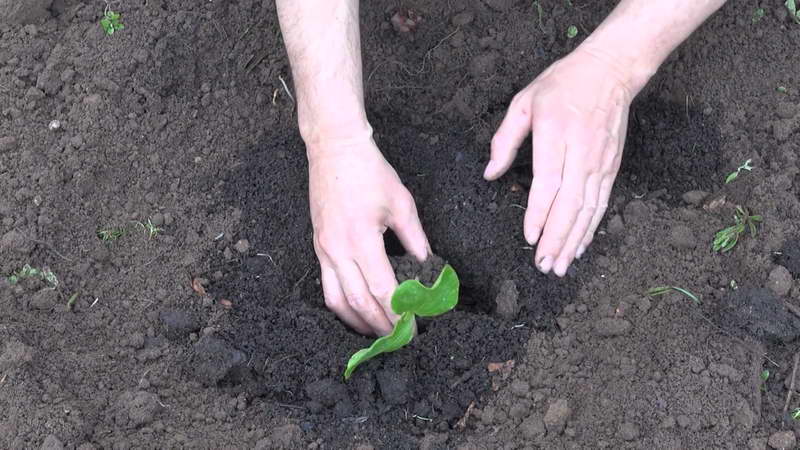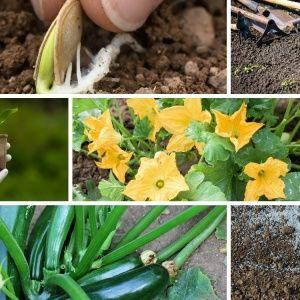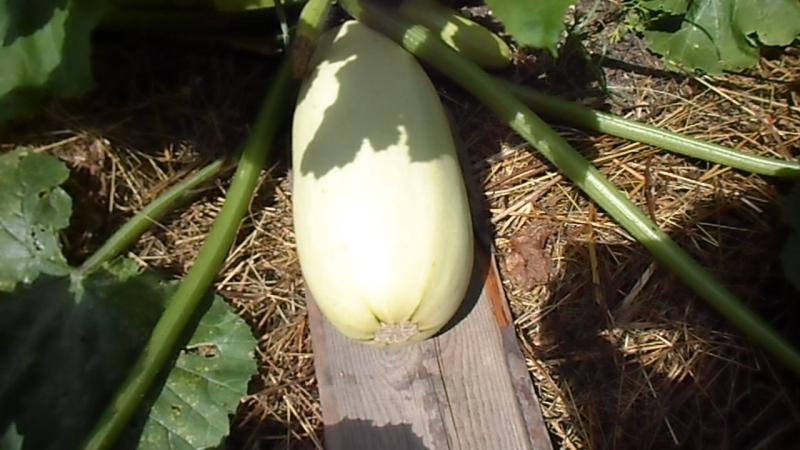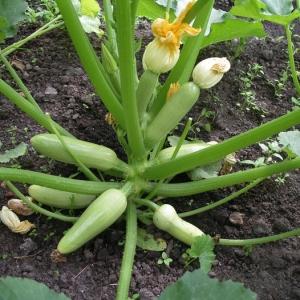Proper cultivation of zucchini and care in the open field: the secrets of agricultural technology for an excellent harvest
Europeans began to eat zucchini only two centuries ago, and learned about its beneficial properties even later. Indeed, the vegetable contains a unique vitamin and mineral composition. Zucchini have a weak taste, which means they can be combined with many products.
Everyone who grows them strives to get a rich harvest of zucchini. Let us examine further the secrets of proper vegetable cultivation and the peculiarities of caring for it.
The content of the article
How to get a rich crop of zucchini
In leaving, the vegetable does not cause much trouble. By nature, he loves warmth and light, so set aside a spacious and calm place for planting zucchini in your area. Below we will consider in detail the basic rules of planting and care.
Then plant
Experienced farmers recommend planting the plant after legumes, cauliflower, cabbage, tomato or potato. Zucchini is grown in the free area of the garden, using small plots of land for 1-2 plants around the perimeter. Many people place the vegetable in potato beds, planting it on the east or north side.
Important! In no case do not plant zucchini after cucumbers, pumpkins, squash.
Seed preparation and planting
The main stage of seed preparation is disinfection. It is carried out to destroy dangerous microorganisms on the surface of the seed. If the seeds are not disinfected, the risk of developing fungi and infections in the future is very high.
To disinfect, place the seeds in a cloth bag, which is immersed in a potassium permanganate solution for half an hour. Then remove the seeds and spread them out in the sun, so they dry from all sides. Also, the drug "Zircon" is used as a disinfectant. The seeds are soaked in it at room temperature for 6-8 hours. "Zircon" increases yield and improves plant immunity.
 For planting, you will need a container with nutrient soil. Make small holes 1-2 cm deep in the ground, place there seed and sprinkle with earth on top. Water the seedlings immediately with warm, settled water, placing them in a warm and bright place.
For planting, you will need a container with nutrient soil. Make small holes 1-2 cm deep in the ground, place there seed and sprinkle with earth on top. Water the seedlings immediately with warm, settled water, placing them in a warm and bright place.
Don't forget to look after your seedlings. Young sprouts need timely watering and feeding, as well as an optimal temperature of at least 20 degrees. Water the sprouts every 5-7 days.
Carry out the first feeding in 2 weeks, then the interval between them is 10-15 days. The seedlings accept organic fertilizers well in the form of bird droppings, ash solution or nettle.
Choosing a place on the site
The ideal place for planting is a bed after peas or cabbage, located on the south side of the garden. Better to plant zucchini in fertile sandy loam soil. The site must be protected from winds. It is also undesirable to find groundwater nearby.
Once the site is selected, proceed to disinfect and fertilize it. Use "Carbation" as a disinfectant. The concentrate is diluted to a 2% aqueous solution and used in soil cultivation."Carbation" has a wide range of applications and protects the plant from root rot and black leg. You can buy it at any gardening store. When using, do not disregard the manufacturer's recommendations and observe the exact dosages.
Fertilize the soil with superphosphate or ammonium nitrate. For example, make a solution based on 30 g of superphosphate and add 1 cup of wood ash to it. Apply fertilizer in dry weather and immediately dig over the beds onto the bayonet to avoid crusting.

Transplanting
How to plant seedlings in the ground? Choose a cloudy and windless day for planting. It is recommended to plant seedlings with lumps of earth on the roots so that the plant takes root better. Be careful not to damage the not yet matured stems and leaves.
After placing the sprout in the ground, sprinkle a generous amount of soil over the roots. After that, pour the zucchini with settled water. For 1 sq. m planted 2-3 plants.
How to care for zucchini during fruiting
First, they double the irrigation rate, by 1 sq. m poured about 15 liters of water. Water in the afternoon, the water temperature should be at least 25 degrees. Secondly, in fruiting, special attention is paid to fertilization. It is important not to let the zucchini wither: use double superphosphate or urea.
Important! During the fruiting period, gardeners use growth stimulants at the rate of 2 liters of solution per 10 sq. m.
Bush formation
Zucchini are most often formed into 1 or 2 stems. Additional shoots (stepchildren) are removed when the zucchini length reaches 10-15 cm. It is recommended to do this 2 times a week. If the plant has grown strongly, then during the fruiting period 2-3 leaves are removed, which cover the vegetables from the sun's rays. Be careful when shaping, because one awkward movement can break brushes with unripe zucchini.
Hilling and loosening
 These procedures provide oxygen to the plant. The first loosening is carried out a week after planting the seedlings in the ground. Better to combine it with weeding and weeding.
These procedures provide oxygen to the plant. The first loosening is carried out a week after planting the seedlings in the ground. Better to combine it with weeding and weeding.
Loosening makes the soil more airy and nutritious. Hilling bushes helps the soil to pass heat and moisture perfectly, which is also indispensable for the plant.
Temperature regime
The optimum air temperature for growing zucchini is at least 22 degrees. In this case, it is imperative to maintain a normal level of air humidity - about 18 degrees. Water temperature for irrigation is at least 25 degrees.
Watering, feeding and fertilizing
Water the zucchini at the rate of 0.5 liters of water per 1 bush. It is best to do this once every 10 days. Remember that cold water increases your risk of developing various diseases. A week before harvesting, watering is stopped altogether. Zucchini is not one of those who like high humidity, so do not overdo it. Be guided by weather conditions: if summers are hot and rainy, reduce the amount of water.
An infusion of mullein or urea is excellent for feeding. Organic matter is especially useful during flowering and fruiting. Also, gardeners recommend scattering humus, peat or dry chicken droppings between the rows of zucchini. When watering, they give the zucchini food and vitamins.
Pay special attention to superphosphate from mineral fertilizers. Make a solution of 30 g of superphosphate and 1 g of boric acid. Apply top dressing at the root of each plant, it will provide the plant with the necessary supply of minerals.
Topping
Zucchini does not need to be pinched. The main thing is to harvest as soon as the vegetable reaches 15-20 cm in length.
Zucchini are formed on the central stem, so harvesting is carried out 2 times a week. However, if the variety of zucchini is large and the bushes grow strongly, then some farmers still pinch them. This is necessary to slow down the growth of the bush.
How to feed zucchini during flowering
 Yeast solution is an excellent means for feeding zucchini during the flowering period.It stimulates the development of bushes, saturates the soil with the necessary bacteria.
Yeast solution is an excellent means for feeding zucchini during the flowering period.It stimulates the development of bushes, saturates the soil with the necessary bacteria.
Yeast is also useful for the root system of the plant, develops resistance to changes in climatic conditions.
The solution is prepared from the following components:
- 80 g dry yeast;
- 8 g sugar;
- 4 g of ascorbic acid;
- 10 liters of filtered water.
The elements are mixed and insisted during the day. It is better to process plants after watering. The yeast solution is affordable and environmentally friendly for zucchini.
We fight pests and diseases
Zucchini is occasionally attacked by a bear. This insect eats the root of the bush, which is why the vegetable itself subsequently rotts. To combat the pest, use "Medvetox", spreading the granules of the drug in the holes. Also, gardeners note the effect of mucus, which is on the leaves and stems. To prevent its appearance, spray the zucchini with a solution of wood ash.
Of the diseases, zucchini most often suffer from bacteriosis. It is caused by wet soil and improper care. When infected, the ovaries turn yellow and rot. Because of this, vegetables stop developing. To combat bacteriosis, use the preparations "Fundazol" or "Topaz".
Collection and storage
It is recommended to collect zucchini as soon as they have grown to 15-30 cm. It is not necessary to overexpose vegetables, as this can harm the entire bush. The harvested crop immediately eat or keep in a dark and cool place. Better if it is a dry basement or cellar.
For the longest storage, the harvest is harvested before the onset of frost... Selected vegetables should have a thick peel and stalk that will dry out over time and protect against infections.

Important! After picking, do not wash the zucchini with water, but simply wipe them with a dry cloth and put them in the sun for a day.
Popular questions
At the forums of gardeners, the features of growing crops and the secrets of a rich harvest are discussed. Here are the answers to some of the most common questions on the web.
Netherflower on zucchini - what to do?
A barren flower is a flower that does not give an ovary, and therefore, no harvest. But do not rush to get rid of them. Barren flowers are also useful, they are able to pollinate the plant. If you pluck a barren flower, the fertilization process is disrupted.
The reasons for the appearance of barren flowers are the wrong planting site, diseases, poor care. Try to identify as quickly as possible the prerequisite for the appearance of barren flowers and eliminate it.
How to distinguish squash seedlings from pumpkin or cucumber?
The main differences are as follows:
- The leaves of cucumber seedlings are more oblong than those of a squash, and have a rounded tip. Pumpkin seedlings have rounded leaves.
- In terms of thickness, cucumbers have the thickest plates, then there is a pumpkin and in the last place are thin leaves of zucchini.
- Zucchini leaves develop much faster than others.
reference... Gardeners use an interesting method: if you rub a cucumber leaf, it does not smell. And pumpkin and zucchini have a peculiar smell that cannot be confused with anything.
Growing tips and tricks

When choosing seeds, trust only a trusted manufacturer. Read the planting guidelines carefully. Do not neglect the disinfection of the seeds, be sure to disinfect them.
For seedlings, purchased ready-made soil is perfect, which already contains the necessary set of nutrients. Use flower pots, wooden crates, or any other dry and clean container for seedlings.
After planting zucchini in open ground, observe the watering regime. Also, remember to regularly loosen the soil and remove weeds. Alternate mineral and organic feed. Examine the plant for the presence of external signs of diseases, if they are found, immediately start treatment.
Important! All dressings are divided into root and foliar.Roots are good for the roots and stem; for this, treat the plant with Ross or Bud. Foliar include spraying with prophylactic drugs. They are carried out once every 2 weeks.
Alternative cultivation methods
In addition to open ground, zucchini are grown in boxes, boxes, bags, buckets. These simple methods will yield a good harvest.
We have prepared for you the rules for growing zucchini in containers:
- Prepare the container, wash it well and dry it. The depth of the container must be at least 0.5 m, and its height must be no more than 1 m.
- Once the container is ready, place the soil in it.
- Make zucchini holes and fill them with organic matter. Place the bush itself on top and sprinkle with earth.
- Water the plant with copious amounts of warm water.
Alternative growing methods are great for those gardeners who do not have enough space to grow a vegetable in their garden. Care is no different from the rules for growing zucchini in the open field. Loosen the soil and fertilize the bushes in time.
Read also:
How to drink zucchini juice: benefits and harms for the body, rules of use.
Preparing stocks of delicious snacks - how to marinate zucchini for the winter.
The advantages and disadvantages of round zucchini, which every summer resident should know.
Conclusion
Growing zucchini in the open field and caring for them is a simple process. Observing simple agronomic rules, gardeners collect tasty and healthy crops. They grow vegetables in the open air, in hotbeds and greenhouses, and even in barrels. The unpretentious plant is used in cooking and medicine. The vegetable is stored for a long time, suitable for dietary nutrition.